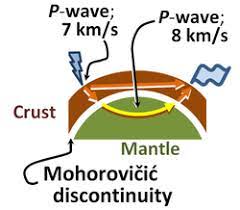The Moho Discontinuity is also known as the Mohorovicic Discontinuity. It is a boundary that separates the Earth’s crust from the underlying mantle. It is named after the Croatian seismologist Andrija Mohorovicic, who first discovered the boundary in 1909.

It is located at an average depth of approximately 35 kilometers beneath the continents and around 5-10 kilometers beneath the ocean floor. It is characterized by a sharp increase in seismic wave velocity as they pass through it, from around 6 kilometers per second in the crust to around 8 kilometers per second in the upper mantle.
The discovery of the Moho Discontinuity was a significant milestone in our understanding of the Earth’s interior. It provided evidence of the existence of a distinct boundary between the crust and the mantle, which was previously thought to be a gradual transition.
It has been used to study the properties of the Earth’s crust and mantle, and how they interact. For example, the thickness and composition of the crust can vary significantly between different regions of the Earth’s surface, and the Moho Discontinuity can provide clues about these variations.
It has also been used to study the behavior of seismic waves that pass through the Earth’s interior. By analyzing the changes in velocity and direction of these waves, scientists can gain insight into the physical properties of the Earth’s interior and the processes that occur within it.
In addition, the Moho Discontinuity has practical applications in the exploration for natural resources such as oil and gas. The discontinuity can act as a barrier that traps these resources, and the study of the Moho Discontinuity can help in identifying potential locations for exploration.
In conclusion, the Moho Discontinuity is an important boundary in the Earth’s interior that separates the crust from the mantle. Its discovery and study have provided valuable insights into the structure and composition of the Earth’s interior, and continue to inform our understanding of the dynamic processes that occur within it.
Important Links